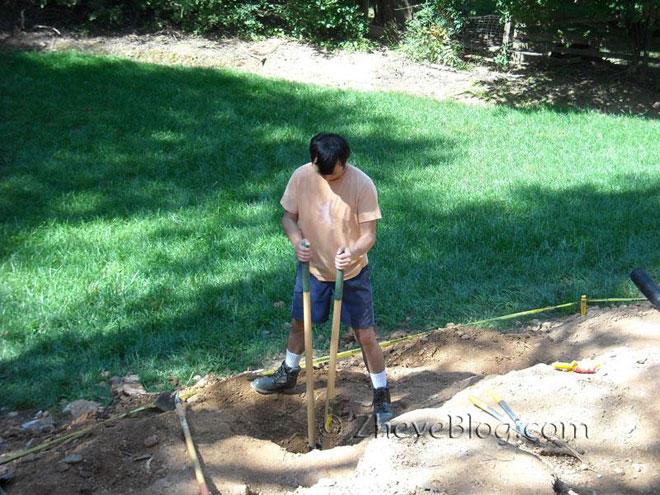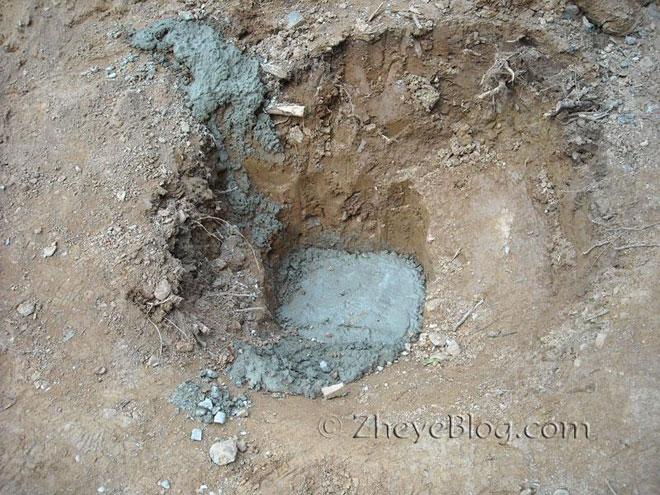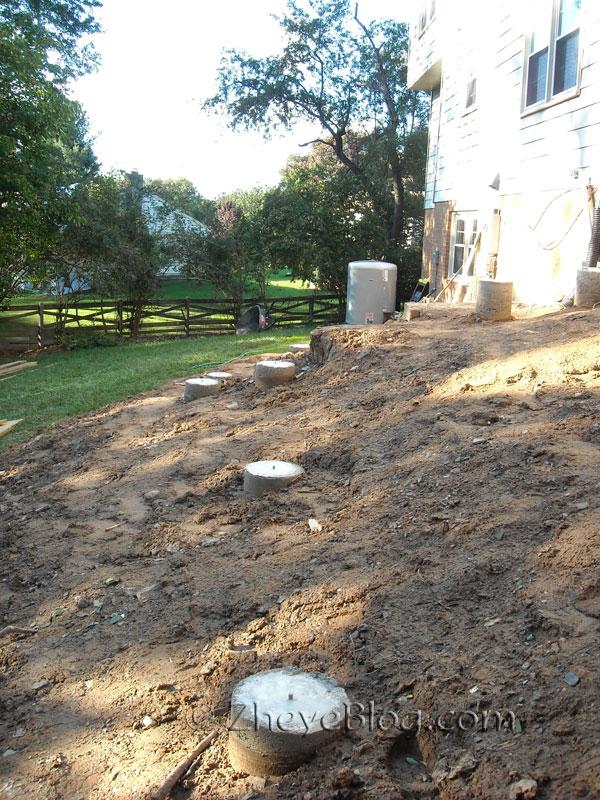( previous blog, first blog of the series )
4. Footing
The surface of the house next to the deck location is brick veneer. The Details prohibits ledger board attachment to brick veneer, so the new deck had to be free-standing, requiring footings to be dug next to the wall. There would be twelve 16 in. square footings, and two 12 in. round footings. Size of footings were clearly defined in the Details.
The Details also requires that when the edge of a deck footing is closer than 5 feet to an existing exterior house wall, the footing must bear at the same elevation as the existing house footings. This is logical because the soil within the 5 feet to a house wall is normally back-fill. Therefore, there were to be seven holes as deep as the house footings. (Footing # 1, 2, 3, 4, 5, 9, and 10.)
Because of tree roots and the closeness of underground utility lines, digging with power tools was not an option. I had to use hand tools to dig all the footings. So, I bought a post-hole digger, a pick, and two small shovels (for our sons to use) in addition to my existing tools. With all the tools on hand we were ready to dig.
I started with hole # 1. To determine the depth of the house foundation, I dug down along the wall. I dug the first 3 feet with post hole digger but did not reach the foundation. I said to myself, “how deep the hole would be?” Since one exposed corner of the house is close to the foundation, I dug there and reached the house foundation. Based on the measurement, I calculated the hole # 1 had to be at least 70-inches deep, which is more than my height. The hole #2, 3, 4, and 9 were about the same depth. The post hole digger is only about 60-inches long. How was I going to dig? It was impossible for me to lie on my stomach and dig. With a shovel in my hand, I stood on the slop, stared blankly at the half-dug hole for quite a while, then I gritted my teeth and decided to trench the slope.
There were eventually three trenches. My two boys (10 and 8 years old back then) often came to help. In late August and early September, the weather in Northern Virginia is still hot. It did not take long to get soaked in sweat while digging under the Sun. At this moment, having a big cup of ice water, the two boys said, it felt so good, never felt that good before.
After digging for about three more afternoons, the first hole was finished. When I went back inside house to have dinner, my elder son said at table, “I had a feeling, dad’s hole would be in vain.” That night and the next day, Hurricane Hanna roared through our area, and flooded hole #1. 
After the rain stopped, I asked boys to get water out with plastic cups attached to a string. They enjoyed playing getting water out of “well” game. The hole dried out in a few days; it looked like this.
After that experience I bought a 20 x 15-ft. tarp from Home Depot, and neighbor Mike lent me two more. If rain was forecast, I covered holes with tarps. There was more rain but the holes did not flooded again.
After the rain, the soil was softer and easier to dig. These were trenches for hole number 1 and 2.
Finished hole number 2.


Hole number 3, 4 and 9. 

I was digging. 
Finished hole number 3, 4 and 9. 


Finished hole number 5 and 10. 
All the holes near the house were finished. I thought the others would be easier to dig because I did not have to dig deep. But there were new challenges.
First, the old deck footings had to be removed. 
Second, I ran into arm-thick tree roots. 
Third, the big tree stump of the big tree removed years before. 
I dug out the old footing at hole number 6, and sawed off the tree roots at hole number 7. But the old footing at hole number 7 would not budge after digging down 20 inches. 
Since I could not continue with hole number 7, I started to work on hole number 8. Bought an ax and chopped off some roots from the big stump, but discovered that under the leg-thick roots (the red circle in the photo), there was another concrete footing! 
I was completely discouraged. I needed help and called the brawny farmer from West Virginia who had cut down trees for us in July, asked him to bring a big hammer and ax. The next day, he arrived with tools and another farmer. They sweated profusely for several hours, knocking out the old footing at hole number 7, chopping off the leg-thick sized roots at hole number 8, and digging out the concrete footing underneath.
They left and I returned to digging myself. 
Finished hole number 8. 
The rest of the holes were relatively easy. Started from the hole number 1, I dug for more than 3 weeks, and developed calluses on my palms. I woke up every morning with every finger sour. But finally, all holes were finished. 
On the night of Sunday, September 21st, I submitted footing inspection request online, requesting the inspection the next day. I was waiting all morning for the inspector. Around 11 AM, I went to pick up mails from my mailbox at the street. When walked back our long driveway, I noticed a piece of paper sticking to the front door. It was the inspection result, and we passed the inspection! I was expecting someone to knock the door. So, the inspector must have gone to the back yard directly, did his thing and left. I dropped the mails and went to the backyard, and saw there was at least one finger-sized dent at the bottom of each hole. I heard that the inspectors would use iron rod to check holes. If the rod can make a deep dent at the bottom of a hole, it will fail inspection. It seemed what I heard was true. The dents in most of the holes were very shallow or not even obvious. Only one hole had 5 or 6 obvious dents at the bottom because a layer of floating dirt in the hole. The inspector must have been very kind; he could have failed me because of that. I got the floating dirt out with a hoe.
The next step was to fill the holes with concrete. When I was digging I asked Mike for recommendation of concrete worker. The worker came after the holes were finished, and gave an estimation of $2,500 for filling holes and constructing the footings. $2,500! That was much more than what I was willing to pay. Forget it, I decided to do it myself!
Checking weather forecast I saw that 2 or 3 days later, there would be rain for 4 consecutive days. If the holes were not filled with concrete, even covered with tarps, the 4-day’s rain would soften the soil around the holes, water might seep in and the holes might collapse. I would have to start all over again. But, if I could get the concrete in within 2 days, the following days of rain would actually be good because a humid environment is good for concrete curing process. Further, the trenches needed to be back-filled and the back fill soil needed water to make it sink down, so the rain would be great for that too. So the thing to do was get the concrete in and construct the footings right now.
I searched for concrete company online and picked one with better price, I called and asked if they could deliver the next day. They said, it usually took about a week to deliver after ordering, but since real estate market was really slow then (year 2008), yes, they could deliver the next day. I asked if they could pour wet concrete directly into the holes from their truck. They asked about the size of our backyard, and the width of our driveway, then said big concrete truck with pump could not get into the backyard. They could only send a small truck, and pour the concrete into a wheelbarrow, then pour it into the holes. But they would charge for the time their truck stays onsite. The charge for the first hour was included in the delivery charge. Afterwards, it was $2 per minute or $120/hour. I said OK, and pre-ordered 4 cubic yard concrete.
Before filling a hole with concrete, it’s better to put a layer of gravel at the bottom for better drainage. So, I bought about 10 bags of gravel from Home Depot, and asked boys to shovel gravel into 14 holes.
To reduce the time of concrete truck stays onsite, I had planned to have the truck dump the concrete on tarp on our driveway, then transport it to the holes with wheelbarrows. So, in addition to a wheelbarrow I bought, I rented one from Home Depot the next morning, and asked a friend of the Boss come and help. Including the Boss, there would be 3 of us moving concrete. Around 11 AM, the concrete truck arrived. Our neighbor Mike saw us, and said the job was for 6-foot-tall men. He said so because I was only 5’6″, and the other two people were ladies. I told the truck driver my plan (dumping the concrete on tarp). The driver said it would not work, because the wet concrete on tarps would set before we could move it to the holes. We decided to try dumping concrete into the wheelbarrow directly, then pour it in the holes. After 2 wheelbarrow loads (with help of the driver), I realized it was quite hard to do. The weight of a 1/3 filled wheelbarrow was over 100 pounds. It was proving almost impossible for me. The driver went to our backyard and saw those trenches for the holes, and thought the truck could get in and pour directly into the holes. So, the concrete truck drove in the backyard.
Taking advantage of the trenches, the truck could pour directly into the holes with extended ducts. In less than 40 minutes, all holes were filled. The driver’s solution greatly saved my labor, saved my time, in turn, saved my money. So, I tipped him very generously afterwards. When we were done, a total of 2.5 cubic yards of concrete was poured into the holes.
Concrete filled hole number 5, 10, 13, and 14. 
Hole number 6. 
Hole number 1. 
Because of the trenches I had dug for the holes, at first concrete could only be filled up to the bottom of the trench, as shown in the photo above. To raise concrete footings above ground, we had to wait for the wet concrete to set then put 12 inches diameter concrete tubes on top of the solid concrete, then pour more concrete into the tubes.
The deck-building books suggest making frames from wooden strips then nailing the frames to the ground with wedges to hold concrete tubes. I had 12 square holes, so I needed to make 12 frames, and many wedges. But, I did not have much time, so I had to figure out another way to do it. The truck poured concrete around noon. By mid-afternoon, the concrete had hardened. At dusk, I bought ten 60-pound bags of concrete mix at Home Depot, and brought them home in our minivan. I marked the location for the tubes on top of the solid concrete, mixed a bag of concrete mix with water in wheelbarrow, asked the Boss to hold concrete tube, and poured the mix into the tube. The layer of concrete at the bottom of the tube was about 6-inches thick. I adjusted the tube to make sure it was perpendicular to ground, then left it to set. After the concrete was set, the 4-foot-long tube was firmly fixed in place. After doing 2 tubes, it was totally dark. Boss got a flashlight, and I kept mixing and pouring; one bag of concrete into each long tube, a half bag into the short tubes. In about an hour, all tubes were fixed. Weather forecast predicted it would start to rain around noon. Then, I only had the morning to finish all the job.
The next day, Boss would have a business trip. In the early morning, after dropped the Boss at the airport, I drove directly to Home Depot. I hired two day laborers, rented a small truck, and a portable electric cement mixer, and bought 35 80-pound bags of concrete mix. All things were brought back with the rented small truck. One laborer was mixing concrete with the electric cement mixer while the other moved it with wheelbarrow and poured it in the tubes. I oversaw the process, and thoroughly mixed and compacted the concrete inside tubes. When a tube was filled, I inserted an 8-inch-long, half inch in diameter J-bolt into the concrete, but left 1-inch thread outside. Around noon rain began with a few scattered drops; we hurried up. But luckily, the rain stopped after the few scattered drops. Around 2 PM, all tubes were filled and all 35 bags of concrete mix were used up. and it started to rain again and it got heavier. But luckily, the job was done. We had to hurry because of the rain and I did not have time to take photos of the process.
I returned the truck and electric cement mixer and had my lunch. The rain eased and the concrete solidified. I started to back fill the trenches. Soon, the kids came back home after school and they took their small shovels and helped with the work. About an hour later, it started to rain again. The kids went inside for dinner, and I kept filling. In the middle of back-filling, I suddenly realized I should take some photos. So, here they are.

It got dark and was still raining. I kept back filling by the light from the house. It was lucky that by the end of September the weather was still warm. I did not feel cold working under rain in T-shirt. By 9 PM, all trenches were back filled, and I called it a day.
Following was footing number 1 after back filling. There was a red plastic bag covering the top to keep the rain off. 
The next morning the back-filling had sank because of rain, and I back filled more dirt. A few days later, the weather was clear, and all footings were ready. 


( next blog )

